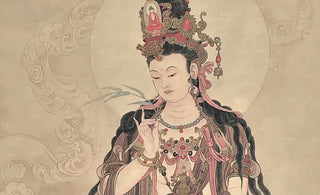
Introduction:
In the rich tapestry of Buddhist mythology and folklore, Avalokiteshvara emerges as a central figure whose compassion resonates through time and space. The bodhisattva, often depicted as the embodiment of compassion, has inspired countless tales that reflect the essence of selfless love, empathy, and altruism. These narratives serve as poignant reminders of the boundless potential for compassion within each individual and offer profound insights into the transformative power of altruistic action.
Avalokiteshvara, the bodhisattva of compassion, stands as a quintessential figure in Buddhist philosophy, epitomizing boundless empathy and mercy. This exploration delves into five facets that illuminate Avalokiteshvara's grace and its profound impact on spiritual seekers and societies worldwide.
1.Iconography and Symbolism:
Avalokiteshvara's iconography embodies compassion's essence. Often depicted with multiple arms and eyes, symbolizing the omnipresence and multifaceted nature of compassion, he holds a white lotus signifying purity and enlightenment. The symbolism of the bodhisattva's manifestations—whether as a male or female figure—underscores the universality of compassion transcending gender or form. Each iconographic element tells a story of compassion's manifold expressions and its relevance across diverse contexts.
2.Cultural Reverence and Spiritual Significance:
Avalokiteshvara's reverence extends far beyond the confines of Buddhism. His depiction resonates deeply within various cultures, where he assumes different names and forms, such as Kuan Yin in East Asian traditions. The bodhisattva's compassionate nature transcends religious boundaries, earning admiration and devotion from followers seeking solace, healing, and guidance. His spiritual significance spans continents, embracing those seeking compassion in times of personal trials or societal upheavals.
3.Stories and Legends: Tales of Compassion:
Mythology and folklore abound with narratives showcasing Avalokiteshvara's compassion. From rescuing devotees in distress to tales of selfless sacrifice, these stories illustrate the bodhisattva's unwavering commitment to alleviating suffering. The recounting of these narratives not only inspires faith and devotion but also serves as a moral compass, urging individuals to emulate compassion in their lives.
One such tale recounts the story of Avalokiteshvara's manifestation as Chenrezig, the deity who vowed never to rest until he had alleviated the suffering of all sentient beings. In this narrative, Avalokiteshvara's commitment to compassion is epitomized by his relentless efforts to rescue devotees from perilous situations. For instance, there is a popular legend where Avalokiteshvara appears in the form of a fisherman to save a group of sailors caught in a treacherous storm. As the tempest rages and the sailors face imminent doom, Avalokiteshvara, moved by their plight, transforms into a mighty sea creature, guiding their ship safely to shore. This tale underscores Avalokiteshvara's unwavering dedication to alleviating suffering, even at the risk of personal sacrifice.
Furthermore, Avalokiteshvara's compassion is exemplified in stories that depict acts of selfless sacrifice for the greater good. One such narrative revolves around Avalokiteshvara's incarnation as a princess named Miao Shan. Despite facing persecution and adversity, Miao Shan embodies the spirit of compassion by dedicating her life to serving others. In a poignant twist, Miao Shan willingly sacrifices her own eyes and limbs to cure her ailing father, demonstrating the bodhisattva's profound understanding of the interconnectedness of all beings and the willingness to endure personal suffering for the sake of others. This tale serves as a powerful allegory for the transformative potential of compassion, illustrating that true fulfillment lies not in self-centered pursuits but in acts of altruism and selfless love.
Moreover, the tales of Avalokiteshvara's compassion extend beyond individual acts of heroism to encompass broader themes of social justice and ethical conduct. For example, Avalokiteshvara is often revered as the patron deity of mercy in many Buddhist traditions, symbolizing the aspiration for a more compassionate and just society. Through stories and legends, Avalokiteshvara's teachings emphasize the importance of cultivating empathy, understanding, and tolerance towards all sentient beings, regardless of their background or circumstances. These narratives inspire individuals to transcend narrow self-interests and embrace a more inclusive and compassionate worldview.
4.Artistic Representation: Sculptures and Depictions:
Avalokiteshvara's grace finds tangible expression in myriad artistic forms—sculptures, paintings, and murals. Each depiction, crafted with meticulous detail, captures the essence of compassion, inviting contemplation and evoking a sense of serenity. These artistic renditions, often featuring the bodhisattva holding a white lotus or displaying a compassionate gesture, serve as visual reminders of humanity's capacity for empathy and kindness.
5.Relevance in Modern Times: Compassion in Practice:
In contemporary society, Avalokiteshvara's message of compassion resonates profoundly. Amidst global challenges, individuals and communities turn to the bodhisattva's teachings, seeking inspiration to navigate complexities with compassion and understanding. Movements advocating for social justice, environmental stewardship, and humanitarian aid draw upon the core values of empathy and altruism embodied by Avalokiteshvara.
Conclusion:
Avalokiteshvara's grace transcends time and cultural boundaries, serving as a timeless beacon of compassion. His multifaceted representations, stories, and teachings continue to inspire and guide countless individuals on the path of empathy, urging humanity to embrace compassion as a fundamental principle in fostering harmony and well-being for all.























